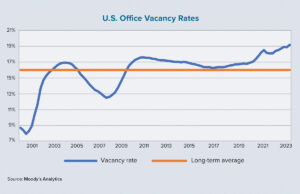In today’s uncertain and volatile landscape for real estate investment, flexibility and adaptability is paramount. As commercial real estate brokers, it’s imperative to stay ahead of the curve, offering clients a diverse array of financing options tailored to their unique needs.
Many traditional lending avenues are pulling back from the market with uncertainty in both interest rate and asset values. This is creating funding gaps and additional equity requirements for otherwise strong deals and some sponsors who would sell or refinance are staying on the sidelines.
Difficult times are when great investors make their best acquisitions and also when there is the most opportunity to gain market share by providing unique solutions to clients while activity is lower and capital is more scarce. This is where alternative financing solutions come into play, providing flexibility, agility and the ability to seize lucrative opportunities that may not be financed through traditional methods.
“Difficult times are when great investors make their best acquisitions and also when there is the most opportunity to gain market share by providing unique solutions to clients while activity is lower, and capital is more scarce.”
Filling the gaps
Some of the alternative financing methods that brokers should know include preferred equity financing, revenue-based lending and mezzanine loans. The following are some of these financial tools that can help brokers meet the needs of clients and stand out from the commercial real estate crowd.
Preferred-equity financing allows investors to have a higher priority than common equity holders in the distributions of cash flow and equity. It is commonly used in large commercial real estate projects to increase the leverage for sponsors or syndicators — groups of investors that pool together their funds to purchase real estate. It is an alternative that fills the gaps between traditional debt and equity financing, offering real estate investors a hybrid solution that combines elements of both.
As the leverage that lenders are willing to offer in the market pulls back, preferred equity allows investors to bring additional capital to a deal behind their first mortgage that has a more flexible payment structure than debt. Preferred equity investors receive an equity stake in the property or entity in exchange for a preferred return.
This structure provides a more favorable split of profits when exiting a deal than traditional joint venture equity. When a real estate investor has a great deal but is short on the equity to finance it based on the more limited availability of capital in the market, preferred equity is often a good answer to close the gap.
“Some of the alternative financing methods that brokers should know include preferred equity financing, revenue-based lending and mezzanine loans.”
Using cash flow
Revenue-based lending, which is also frequently referred to as cash-flow-based financing, is gaining traction as a viable, popular, fast and easy-to-obtain financing option for real estate investors with positive cash flow on their stabilized rental real estate properties. It is a method for raising capital for a business by paying a fixed percentage of the company’s revenue to the lender.
Instead of relying solely on credit scores and collateral, revenue-based lenders assess a borrower’s ability to repay based on the property’s cash flow and revenue projections. Revenue-based lending is a great option for investors who own commercial projects that have cash flow, but need some additional capital to conduct needed improvements. It is also useful for owners looking to leverage their stabilized properties to access capital to buy new opportunities without having to sell their assets.
Debt combination
Mezzanine financing is similar to preferred equity, but there is typically more payment flexibility. This type of financing is a hybrid of debt and equity financing that gives the lender the right to convert the debt to an equity interest in the company under certain circumstances. It exists between senior debt and common equity as either subordinate debt, preferred equity or a combination of the two.
By layering a mezzanine loan atop first mortgage debt, investors can access additional capital while minimizing equity dilution. Mezzanine products are particularly well-suited for investors looking to secure a lower overall cost of capital by combining a low-leverage first mortgage at a low rate and a higher leverage second position loan at a higher rate. Although the mezzanine loan is more expensive than a first mortgage would be, the combination is cheaper than going with a single high-leverage, high-rate first mortgage because the higher rate is on a smaller loan balance.
During the boom years of 2020 and 2021, there was plenty of capital available in the market and traditional sources were able to provide the leverage and flexibility needed to capitalize most of the opportunities available. As rates have risen, capital has become more constrained and some traditional sources have pulled back or have become much more conservative on terms such as loan to value, interest rate and general underwriting and liquidity covenants.
This has made it harder for real estate investors to operate and grow their portfolios. It is also creating great opportunities as capital-constrained owners are and will continue to be forced to sell properties to pay off debts that they incurred during the bull market.
● ● ●
Embracing alternative avenues for financing will help commercial real estate brokers bring a unique set of tools to their clients at a time when many of their competitors are offering traditional options that aren’t sufficient to finance deals in our current environment. Market volatility creates losers and winners.
With interest rates remaining stubbornly high, asset prices falling and traditional capital being used more conservatively, the people who adapt quickly to this new reality will take market share and benefit from these changes. By staying informed, adaptable and innovative, you can forge stronger partnerships your clients and drive mutual success in the dynamic landscape of commercial real estate.
Author
-

Derrick Barker is CEO of Nectar, which provides financing to professional real estate investors with low-leveraged, cash-flowing assets. He and his wife, Brittany Mosely, co-founded the company. Barker started building his real estate portfolio in 2010 as a senior at Harvard University. He transitioned into buying multifamily properties while working as a bond trader at Goldman Sachs. Barker and Mosely launched Nectar to provide mezzanine-level financing in real estate portfolios in a variety of asset classes.





